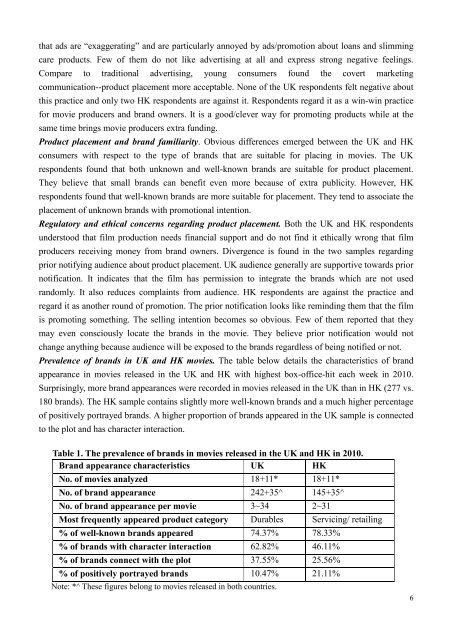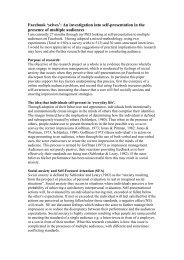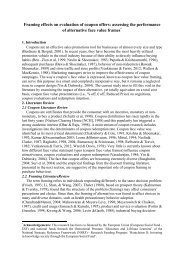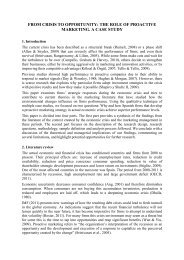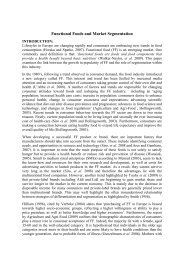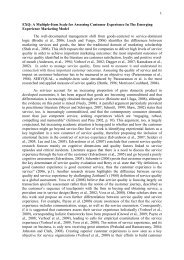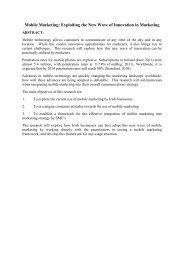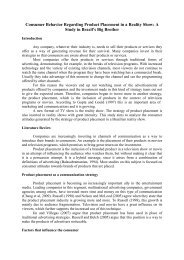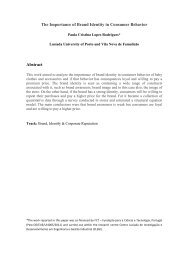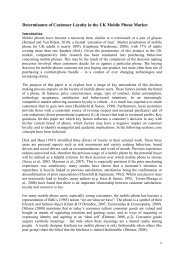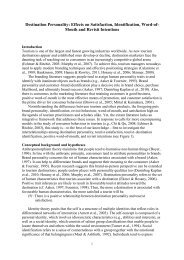that ads are “exaggerat<strong>in</strong>g” and are particularly annoyed by ads/promotion about loans and slimm<strong>in</strong>g care products. Few <strong>of</strong> them do not like advertis<strong>in</strong>g at all and express strong negative feel<strong>in</strong>gs. Compare to traditional advertis<strong>in</strong>g, young consumers found the covert market<strong>in</strong>g communication--product placement more acceptable. None <strong>of</strong> the UK respondents felt negative about this practice and only two HK respondents are aga<strong>in</strong>st it. Respondents regard it as a w<strong>in</strong>-w<strong>in</strong> practice for movie producers and brand owners. It is a good/clever way for promot<strong>in</strong>g products while at the same time br<strong>in</strong>gs movie producers extra fund<strong>in</strong>g. <strong>Product</strong> placement and brand familiarity. Obvious differences emerged between the UK and HK consumers with respect to the type <strong>of</strong> brands that are suitable for plac<strong>in</strong>g <strong>in</strong> movies. The UK respondents found that both unknown and well-known brands are suitable for product placement. They believe that small brands can benefit even more because <strong>of</strong> extra publicity. However, HK respondents found that well-known brands are more suitable for placement. They tend to associate the placement <strong>of</strong> unknown brands with promotional <strong>in</strong>tention. Regulatory and ethical concerns regard<strong>in</strong>g product placement. Both the UK and HK respondents understood that film production needs f<strong>in</strong>ancial support and do not f<strong>in</strong>d it ethically wrong that film producers receiv<strong>in</strong>g money from brand owners. Divergence is found <strong>in</strong> the two samples regard<strong>in</strong>g prior notify<strong>in</strong>g audience about product placement. UK audience generally are supportive towards prior notification. It <strong>in</strong>dicates that the film has permission to <strong>in</strong>tegrate the brands which are not used randomly. It also reduces compla<strong>in</strong>ts from audience. HK respondents are aga<strong>in</strong>st the practice and regard it as another round <strong>of</strong> promotion. The prior notification looks like rem<strong>in</strong>d<strong>in</strong>g them that the film is promot<strong>in</strong>g someth<strong>in</strong>g. The sell<strong>in</strong>g <strong>in</strong>tention becomes so obvious. Few <strong>of</strong> them reported that they may even consciously locate the brands <strong>in</strong> the movie. They believe prior notification would not change anyth<strong>in</strong>g because audience will be exposed to the brands regardless <strong>of</strong> be<strong>in</strong>g notified or not. Prevalence <strong>of</strong> brands <strong>in</strong> UK and HK movies. The table below details the characteristics <strong>of</strong> brand appearance <strong>in</strong> movies released <strong>in</strong> the UK and HK with highest box-<strong>of</strong>fice-hit each week <strong>in</strong> 2010. Surpris<strong>in</strong>gly, more brand appearances were recorded <strong>in</strong> movies released <strong>in</strong> the UK than <strong>in</strong> HK (277 vs. 180 brands). The HK sample conta<strong>in</strong>s slightly more well-known brands and a much higher percentage <strong>of</strong> positively portrayed brands. A higher proportion <strong>of</strong> brands appeared <strong>in</strong> the UK sample is connected to the plot and has character <strong>in</strong>teraction. Table 1. The prevalence <strong>of</strong> brands <strong>in</strong> movies released <strong>in</strong> the UK and HK <strong>in</strong> 2010. Brand appearance characteristics UK HK No. <strong>of</strong> movies analyzed 18+11* 18+11* No. <strong>of</strong> brand appearance 242+35^ 145+35^ No. <strong>of</strong> brand appearance per movie 3~34 2~31 Most frequently appeared product category Durables Servic<strong>in</strong>g/ retail<strong>in</strong>g % <strong>of</strong> well-known brands appeared 74.37% 78.33% % <strong>of</strong> brands with character <strong>in</strong>teraction 62.82% 46.11% % <strong>of</strong> brands connect with the plot 37.55% 25.56% % <strong>of</strong> positively portrayed brands 10.47% 21.11% Note: *^ These figures belong to movies released <strong>in</strong> both countries. 6
References: Avery, R.J. and Ferraro, R. (2000). Verisimilitude or advertis<strong>in</strong>g? Brand appearances on prime-time television. Journal <strong>of</strong> Consumer Affairs, 34(2), 217-244. Balasubramanian, S.K., Karrh, J.A., and Patwardhan, H. (2006). Audience response to product placements: An <strong>in</strong>tegrative framework and future research agenda, Journal <strong>of</strong> Advertis<strong>in</strong>g, 35(3), 115-141. Cadogan, J.W. (2010). Comparative, cross-cultural and cross-national research: A comment on good and bad practice. International Market<strong>in</strong>g Review, 27(6), 601-605. Cowley, E. and Barron, C. (2008). When product placement goes wrong: the effects <strong>of</strong> program lik<strong>in</strong>g and placement prom<strong>in</strong>ence. Journal <strong>of</strong> Advertis<strong>in</strong>g, 37(1), 89-98. Craig-Lees, M., Scott, J. and Wong, R. (2008). Perceptions <strong>of</strong> product placement practice across Australian and US practitioners. Market<strong>in</strong>g Intelligence & Plann<strong>in</strong>g, 26(5), 521-538. d’Astous, A. and Segu<strong>in</strong>, N. (1999). Consumer reactions to product placement strategies <strong>in</strong> television sponsorship. European Journal <strong>of</strong> Market<strong>in</strong>g, 33(9/10), 896-910. Diehl, S., Terlutter, R. and Mueller, B. (2008). The <strong>in</strong>fluence <strong>of</strong> culture on responses to the GLOBE dimension <strong>of</strong> performance orientation <strong>in</strong> advertis<strong>in</strong>g messages - Results from the US, Germany, France, Spa<strong>in</strong>, and Thailand. Advances <strong>in</strong> Consumer Research, 35, 269-275. Eaton, M. (2009). <strong>Product</strong> placement makes its debut Ontv. [Onl<strong>in</strong>e]. Available from: http://www.market<strong>in</strong>g-<strong>in</strong>teractive.com/news/10747 [Accessed 15 March 2011]. Eisend, M. (2009). A cross-cultural generalizability study <strong>of</strong> consumers’ acceptance <strong>of</strong> product placements <strong>in</strong> movies. Journal <strong>of</strong> Current Issues and Research <strong>in</strong> Advertis<strong>in</strong>g, 31, 15-26. Friestad, M. and Wright, P. (1994). The persuasion knowledge model: how people cope with persuasion attempts, Journal <strong>of</strong> Consumer Research, 21(June), 1-31. Friestad, M. and Wright, P. (1995). Persuasion knowledge model: Lay people’s and researcher’s beliefs about the psychology <strong>of</strong> persuasion, Journal <strong>of</strong> Consumer Research, 22(June), 62-74. Gould S.J., Gupta P.B. and Grabner-Kräuter, S. (2000). <strong>Product</strong> placements <strong>in</strong> movies: A cross-cultural analysis <strong>of</strong> Austrian, French and American consumers’ attitudes toward this emerg<strong>in</strong>g <strong>in</strong>ternational promotional medium. Journal <strong>of</strong> Advertis<strong>in</strong>g, 29(4), 41-58. Gregorio, F. and Sung, Y. (2010). Understand<strong>in</strong>g attitudes toward and behaviours <strong>in</strong> response to product placement. Journal <strong>of</strong> Advertis<strong>in</strong>g, 39(1), 83-96. Hackley, C. and Tiwsakul, R. (2006). Enterta<strong>in</strong>ment market<strong>in</strong>g and experiential consumption. Journal <strong>of</strong> Market<strong>in</strong>g Communications, 12(1), 63-75. Homer, P.M. (2009). <strong>Product</strong> placements: The impact <strong>of</strong> placement type and repetition on attitude. Journal <strong>of</strong> Advertis<strong>in</strong>g, 38 (3), 21-32. House, R.J., Hanges, P.W., Javidan, M., P. Dorfman, and V. Gupta (2004).Culture, Leadership, and Organizations: The GLOBE Study <strong>of</strong> 62 Societies. Thousand Oaks CA: Sage Publications. Karrh, J.A. (1998). Brand placement: A review. Journal <strong>of</strong> Current Issues and Research <strong>in</strong> Advertis<strong>in</strong>g, 20(2), 31-49. Karrh, J.A., Frith, K.T., and Callison, C. (2001). Audience attitudes towards brand (product) placement: S<strong>in</strong>gapore and United States. International Journal <strong>of</strong> Advertis<strong>in</strong>g, 20(1), 3-24. Karrh, J.A., McKee, K.B. and Pardun, C.J. (2003). Practitioners’ evolv<strong>in</strong>g views on product placement effectiveness. Journal <strong>of</strong> Advertis<strong>in</strong>g Research, 43(2), 138-149. La Ferle, C. and Edwards, S. M. (2006). <strong>Product</strong> placement: How brands appear on television. Journal <strong>of</strong> Advertis<strong>in</strong>g, 35 (4), 65-86. McCarty, J. A. (2004). <strong>Product</strong> placement: The nature <strong>of</strong> the practice and potential avenues <strong>of</strong> <strong>in</strong>quiry. In L. J. Shrum (Ed.), The Psychology <strong>of</strong> Enterta<strong>in</strong>ment Media (pp. 45-61). Mahwah, NJ: Lawrence Erlbaum. McKechnie, S. and Zhou, J. (2003). <strong>Product</strong> placement <strong>in</strong> movies: a comparison <strong>of</strong> Ch<strong>in</strong>ese and American consumers' attitudes. International Journal <strong>of</strong> Advertis<strong>in</strong>g, 22(2), 349-374. Okazaki, S., Mueller. B. and Taylor, C. (2010). Global consumer culture position<strong>in</strong>g: Test<strong>in</strong>g perceptions <strong>of</strong> s<strong>of</strong>t-sell and hard-sell advertis<strong>in</strong>g appeals between U.S. and Japanese consumers. Journal <strong>of</strong> International Market<strong>in</strong>g, 18(2), 20-34. Pae, J., Samiee, S. and Tai, H.C. (2002). Global advertis<strong>in</strong>g strategy: The moderat<strong>in</strong>g role <strong>of</strong> brand familiarity and execution style. International Market<strong>in</strong>g Review, 19 (2), 176-189. Pardun, C.J. and McKee, K.B. (2000). <strong>Product</strong> placements as public relations: An exploratory study <strong>of</strong> the role <strong>of</strong> the public relations firm. Public Relations Review, 25(4), 481-493. Petty, R.E. and Cacioppo, J.T. (1981). Attitudes and Persuasion: Classic and Contemporary Approaches. Dubuque, IA: Wm. C. Brown. Petty, R.E. and Cacioppo, J.T. (1986). The elaboration likelihood model <strong>of</strong> persuasion. In L. Berkowitz (Ed.), Advances <strong>in</strong> Experimental Social Psychology (Vol.19, pp.123-205). New York: Academic Press. PQ Media (2007). Media global product placement forecast series 2006-2010: Country-by-country analysis. Stamford, CT. Russell, C.A. (2002). Investigat<strong>in</strong>g the effectiveness <strong>of</strong> product placements <strong>in</strong> television shows: the role <strong>of</strong> modality and plot connection congruence on brand memory and attitude. Journal <strong>of</strong> Consumer Research, 29(3), 306-319. Russell, C.A. and Belch, M. (2005). A managerial <strong>in</strong>vestigation <strong>in</strong>to the product placement <strong>in</strong>dustry. Journal <strong>of</strong> Advertis<strong>in</strong>g Research, 45(1), 73-92. Smit, E., Van Reijmersdal, E. and Neijens, P. (2009). Today’s practice <strong>of</strong> brand placement and the <strong>in</strong>dustry beh<strong>in</strong>d it. International Journal <strong>of</strong> Advertis<strong>in</strong>g, 28(5), 761-782. Sung, Y., Gregorio, F. and Jung, J. (2009). Non-student consumer attitudes towards product placement: Implications for public policy and advertisers. International Journal <strong>of</strong> Advertis<strong>in</strong>g, 28 (2), 257-285. Taylor, C.R. (2009). <strong>Product</strong> placement: a hot topic gets hotter. International Journal <strong>of</strong> Advertis<strong>in</strong>g, 28(5), 753-756. Terlutter, R., Diehl S. and Mueller B. (2010). The cultural dimension <strong>of</strong> assertiveness <strong>in</strong> cross-cultural advertis<strong>in</strong>g: The perception and evaluation <strong>of</strong> assertive advertis<strong>in</strong>g appeals. International Journal <strong>of</strong> Advertis<strong>in</strong>g, 29(3), 369-339. Tiwsakul, A.R., Hackley, C. and Szmig<strong>in</strong>, I. (2005). Explicit, non-<strong>in</strong>tegrated product placement <strong>in</strong> British television programmes. International Journal <strong>of</strong> Advertis<strong>in</strong>g, 24(1), 95-111. Tsai, M., Liang, W., and Liu, M. (2007). The effects <strong>of</strong> sublim<strong>in</strong>al advertis<strong>in</strong>g on consumer attitudes and buy<strong>in</strong>g <strong>in</strong>tentions. International Journal <strong>of</strong> Management, 24(1), 3-14. Van Reijmersdal, E., Neijens, P. and Smit, E. (2007). Effects <strong>of</strong> television brand placement on brand image. Psychology and Market<strong>in</strong>g, 24(5), 403-420. 7


